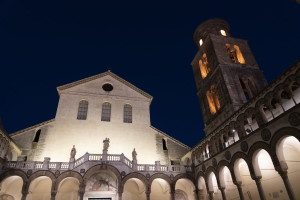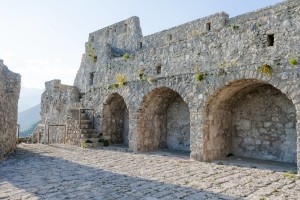Salerno is one of Southern Italy’s biggest hidden treasures without a doubt. Located near the Amalfi Coast and less than an hour from Naples, the second-largest city of Campania is a genuine gem brimming with cosiness. Comparatively few tourists end up in Salerno due to its proximity to some of the most popular attractions of the entire region, but there are so many amazing things for you to discover here. The coastal city has an abundance of glorious sights, palpable history and Mediterranean flair with its countless cafés, bars and restaurants. And don’t even get us started on the small but definitely nice seafront! Enough talk, let’s explore the city of arts Salerno together.
Trade centre, medical school, touristic relaunch
Salerno’s ideal location attracted first populations very early on. There had already been settlements in the area between the 9th and the 6th century BC as confirmed by the discovery of Neolithic mummy remains. Later colonised by the Etruscans and eventually controlled by the Romans, the former military fortification turned into a flourishing trade centre. Salerno reached its heyday during Lombard rule with the famous Medical School of Salerno where an independent occidental medicine was created during the 11th century. The Normans made Salerno their capital when they were conquering the south of Italy.
Joining Amalfi, Salerno once again became an important trade centre in the High Middle Ages, this time for Northern Africa and Sicily. The city’s fate was later tied closely to that of the Kingdom of Naples. There was another cultural, economic and medical boom under the rule of the Counts of Sanseverino, but their expropriation and exiling lead to a sharp, steady decline expedited by an outbreak of the plague and by severe earthquakes. The city finally began to grow again at a fairly fast rate from 1830 onward, having been an important part of the Risorgimento and early industrialisation, yet it wasn’t until late into the second half of the 20th century that the renewed focus on tourisms reinvigorated the historic centre.
Salerno’s churches

©Bigstock.com/Claudiogiovanni
During the 1990s, when the initial touristic construction boom had begun to subside a bit, there was a focus on renovating and restoring classic sights, and there are plenty of them in Salerno. Let’s check out the churches first:
- Cattedrale di Salerno: Construction of the Cathedral of San Matteo began in 1080, three years after the Normans had seized power from the Lombards. It is the oldest big church of Arabic-Norman architecture from a time before the introduction of pointed arches. 28 ancient pillars and various Roman sarcophagi grace the portico. The crypta supposedly harbours the remains of Matthew the Apostle.
- Sant’Andrea de Lavina: The small river Lavina used to act as a drainage channel of sorts and stills runs below a road near this 9th century church. The fascinating thing about Sant’Andrea de Lavina is how ongoing excavations have made the former use of this site as a cemetery palpable in a very vivid manner.
- Chiesa San Pietro a Corte: The term “church” might be a bit deceptive in this context as San Pietro a Corte actually houses a large archaeological complex with (presumed) ruins of Roman baths, an early Christian burial site, a potential hall of the Medical School of Salerno, and a 12th century chapel. There are, however, small churches, chapels and other buildings on and around this site.
- Santa Maria de Lama: We have one more church for you and – what a surprise! – it actually is one. Santa Maria de Lama was built during the Lombard heyday between the 10th and the 11th There are some fresco fragments – the only evidence of Lombard painting – inside the church.
The palaces of the city
We’re only getting started now and are taking a step back from the city’s diverse religious architecture. Salerno’s palazzi are incredibly colourful and spectacular:
- Palazzo di Città di Salerno: Built in 1936 in the characteristic fascistic style of its time, it served as the meeting room for the first Government of the Kingdom of Italy only eight years later. Aside from housing the mayor’s office, the large cinema theatre on the ground floor is one of the most popular event sites of the city.
- Palazzo Fruscione: This palace in the oldest part of the historic centre doesn’t just look pretty amazing, it harbours many a treasure below the ground. It might have been the site of the palace of the Lombard Duke Arechis II who ruled over the region from 758 to 787. Mosaics and frescoes from the 2nd century and the ruins of a thermal bath complex were found here, too.
- Palazzo Pinto: The former palace of the eponymous noble family saw many a conversion throughout the years – the current design likely dates back to the mid-17th century – but you might still discover some rather exciting medieval traces here and there. The cornices and arches are of Norman origin. Palazzo Pinto currently houses a small but lovely art gallery.
- Palazzo Santoro: Florentine architect Gino Coppedè imaginatively designed an area of more than 30,000 m² in the Roman district Trieste in the style of Italian Art Nouveau between 1915 and 1926. Palazzo Santoro is one of his very rare works in Campania. The seven-storey building on the waterfront is an eclectic, bizarre masterpiece; like a fairy-tale from a different time.
Even more sights in Salerno

©Bigstock.com/tanialerro
You’re probably like us and just can’t get enough of Salerno. Don’t worry, we’ve got you covered with another ace up our sleeve. Well, four aces, to be precise:
- Museo Archeologico Provinciale: Experience the historical and cultural transformations of the Salerno region when visiting the archaeological museum. Finds from the Stone Age to the Middle Ages exhibit Samnite, Etruscan and Roman pieces. The head of the Apollo by Pasiteles was actually discovered in a fishing net and is among the most beautiful exhibits of this vast collection.
- Castello di Arechi: One of the city’s oldest monuments is located on a hill some 300 m above sea level. Arechis II extended an old Roman-Byzantine fortification to create this imposing fortress. There’s a museum exhibiting various finds from the castle’s storied history. The amazing observation decks will wow you with their clear views of the Gulf of Salerno.
- Forte La Carnale: Regional entrepreneur Andrea Di Gaeta had this fort built in 1569 as part of the defensive structure to protect Salerno from repeated Saracen raids. It has since been incorporated into a large sports complex with an enchanting garden. On clear days you can even see the Amalfi Coast and the Coast of Cliento.
- Giardino della Minerva: Talking about gardens – what was originally established as a didactic facility for Salerno’s Medical School has since become one of Italy’s most beautiful botanical gardens. See more than 300 different plant species including rarities used in medieval medicine in thematically grouped areas.
The city of arts Salerno might not be the biggest touristic hotspot, most certainly due to its proximity to Naples and the Amalfi Coast. However, that’s exactly what makes this beauty in Campania fascinating. Whether you’re interested in the city’s truly spectacular history or just want to stroll up and down the historic centre – there’s always a ravishing archaeological discovery to be made and a cup of coffee with your name on it, sea view included.